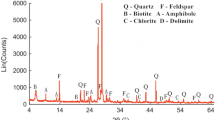Conclusions
Investigations of refractories made from Polozhe and Novoselits kaolins and fired in oxidizing and reducing conditions showed that development of the properties and phase composition occurs during heating to a certain temperature, in the process of soaking and cooling to 1200°C. The properties of kaolin refractories and their phase composition depend on the atmosphere, the firing temperature, soaking, and cooling rate. These factors are the main means of regulating the properties of refractories.
Similar content being viewed by others
References
N. V. Pitak, R. M. Fedoruk, R. S. Shulyak, et al., “Increasing the quality of refractories for lining blast furnaces,” Ogneupory, No. 8, 20–28 (1976).
N. Namaysy, Tonindustrie-Zeitung,101, No. 5/6, 149–172 (1977).
N. V. Pitak, R. M. Fedoruk, T. P. Khmelenko, et al., “Relationship between the properties of chamotte and the pellets' firing cycle,” Ogneupory, No. 3, 22–28 (1982).
Author information
Authors and Affiliations
Additional information
Translated from Ogneupory, No. 9, pp. 5–7, September, 1993.
Rights and permissions
About this article
Cite this article
Pitak, N.V., Fedoruk, R.M. Formation of kaolin refractories heated in different gaseous atmospheres. Refractories 34, 454–457 (1993). https://doi.org/10.1007/BF01295023
Issue Date:
DOI: https://doi.org/10.1007/BF01295023




